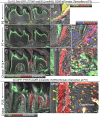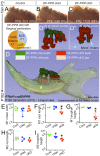Autocrine regulation of mesenchymal progenitor cell fates orchestrates tooth eruption
- PMID: 30509999
- PMCID: PMC6329940
- DOI: 10.1073/pnas.1810200115
Autocrine regulation of mesenchymal progenitor cell fates orchestrates tooth eruption
Abstract
Formation of functional skeletal tissues requires highly organized steps of mesenchymal progenitor cell differentiation. The dental follicle (DF) surrounding the developing tooth harbors mesenchymal progenitor cells for various differentiated cells constituting the tooth root-bone interface and coordinates tooth eruption in a manner dependent on signaling by parathyroid hormone-related peptide (PTHrP) and the PTH/PTHrP receptor (PPR). However, the identity of mesenchymal progenitor cells in the DF and how they are regulated by PTHrP-PPR signaling remain unknown. Here, we show that the PTHrP-PPR autocrine signal maintains physiological cell fates of DF mesenchymal progenitor cells to establish the functional periodontal attachment apparatus and orchestrates tooth eruption. A single-cell RNA-seq analysis revealed cellular heterogeneity of PTHrP+ cells, wherein PTHrP+ DF subpopulations abundantly express PPR. Cell lineage analysis using tamoxifen-inducible PTHrP-creER mice revealed that PTHrP+ DF cells differentiate into cementoblasts on the acellular cementum, periodontal ligament cells, and alveolar cryptal bone osteoblasts during tooth root formation. PPR deficiency induced a cell fate shift of PTHrP+ DF mesenchymal progenitor cells to nonphysiological cementoblast-like cells precociously forming the cellular cementum on the root surface associated with up-regulation of Mef2c and matrix proteins, resulting in loss of the proper periodontal attachment apparatus and primary failure of tooth eruption, closely resembling human genetic conditions caused by PPR mutations. These findings reveal a unique mechanism whereby proper cell fates of mesenchymal progenitor cells are tightly maintained by an autocrine system mediated by PTHrP-PPR signaling to achieve functional formation of skeletal tissues.
Keywords: dental follicle; in vivo lineage-tracing experiment; mesenchymal progenitor cells; parathyroid hormone-related peptide; tooth eruption.
Copyright © 2019 the Author(s). Published by PNAS.
Conflict of interest statement
The authors declare no conflict of interest.
Figures





Comment in
-
Shedding new light on the mysteries of tooth eruption.Proc Natl Acad Sci U S A. 2019 Jan 8;116(2):353-355. doi: 10.1073/pnas.1819412116. Epub 2019 Jan 2. Proc Natl Acad Sci U S A. 2019. PMID: 30602459 Free PMC article. No abstract available.
References
-
- Sacchetti B, et al. Self-renewing osteoprogenitors in bone marrow sinusoids can organize a hematopoietic microenvironment. Cell. 2007;131:324–336. - PubMed
Publication types
MeSH terms
Substances
Grants and funding
LinkOut - more resources
Full Text Sources
Molecular Biology Databases
Research Materials
Miscellaneous

